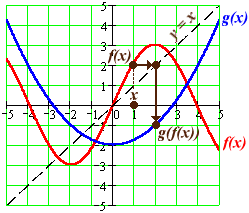| Compositions | Click here to open an associated Mathcad worksheet: |
Transformations provide basic methods for modifying "known" functions into versions that describe particular situations. Compositions, on the other hand, provide the nails and the glue that allow you to assemble functions and their transformations into larger models.
You already know about "assembled" functions. E.g., when we write:
![]()
it is understood that the output y is computed from the input x in three distinct steps:
![]() .
.
We say that the rule for f is composed of the three separate rules u , v , and w , executed in that order. We write
You can see that, beginning with a toolkit of just a few families of funtions and their transformations, we can "compose" functions of arbitrary complexity.
Composition is the essence of model building. It is rare that we can look at a complex physical process and immediately write down a function that accurately describes the entire input-output behavior of that process. It is much more likely that we will come to think of a physical process in terms of a series of much smaller component processes, write down a simple function to model each component, and then assemble the component functions into a chain of dependencies using composition.
Just as for transformations, you can gain a better understanding of compositions if you can picture them as well as compute them. Graphically, a composition g(f(x)) might look like this:

The input x is first located on the x-axis, and the "intermediate" output
|
|
|
|
| Back to Contents | ||